Wildfire modeling
We develop process-based models and hybrid AI models for wildfire studies.
Wildfires are occurring with increasing frequency and severity worldwide, leading to escalating economic, ecological, and social losses. Yet despite their growing importance, current wildfire models remain limited in their ability to capture the full complexity of fire dynamics. Many critical processes—including vegetation flammability, fuel–climate interactions, human ignition patterns, and feedbacks between fire, atmosphere, and ecosystems—are still poorly represented in existing frameworks. Our research seeks to advance wildfire modeling by integrating process-based approaches with hybrid artificial intelligence models to improve predictions of fire occurrence, spread, and burn area at regional to global scales. In parallel, we are deeply interested in understanding the ecological consequences of wildfire, including carbon and nutrient cycling, habitat shifts, and biophysical feedbacks to the climate system. We also study post-fire ecosystem recovery, with particular focus on vegetation regrowth, soil stabilization, and hydrological responses. Together, this work aims to provide both mechanistic insights and actionable tools for anticipating wildfire risks and informing management strategies that foster resilience in coupled human–natural systems.

Related publications:
2025
- Exacerbating risk in human-ignited large fires over western United States due to lower flammability thresholds and greenhouse gas emissionsPNAS Nexus, Feb 2025
2024
- Projecting large fires in the western US with an interpretable and accurate hybrid machine learning methodEarth’s Future, Feb 2024
2022
- AttentionFire_v1. 0: interpretable machine learning fire model for burned area predictions over tropicsGeoscientific Model Development Discussions, Feb 2022
- Building a machine learning surrogate model for wildfire activities within a global Earth system modelGeoscientific Model Development, Feb 2022